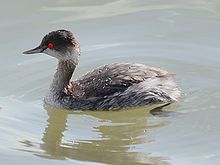Podicipediformes
| Grebes Temporal range: Oligocene-Holocene, 25–0 Ma |
|
|---|---|
 |
|
| Black-necked grebe (Podiceps nigricollis nigricollis), in non-breeding plumage | |
| Scientific classification | |
| Kingdom: | Animalia |
| Phylum: | Chordata |
| Class: | Aves |
| Clade: | Aequorlitornithes |
| Clade: | Mirandornithes |
| Order: |
Podicipediformes Fürbringer, 1888 |
| Family: |
Podicipedidae Bonaparte, 1831 |
| Genera | |
A grebe (/ˈɡriːb/) is a member of the order Podicipediformes and the only type of bird associated with this order.
Grebes are a widely distributed order of freshwater diving birds, some of which visit the sea when migrating and in winter. This order contains only a single family, the Podicipedidae, containing 22 species in 6 extant genera.
Grebes are small to medium-large in size, have lobed toes, and are excellent swimmers and divers. Although they can run for a short distance, they are prone to falling over, since they have their feet placed far back on the body.
Grebes have narrow wings, and some species are reluctant to fly; indeed, two South American species are completely flightless. They respond to danger by diving rather than flying, and are in any case much less wary than ducks. Extant species range in size from the least grebe, at 120 grams (4.3 oz) and 23.5 cm (9.3 inches), to the great grebe, at 1.7 kg (3.8 lbs) and 71 cm (28 inches).
The North American and Eurasian species are all, of necessity, migratory over much or all of their ranges, and those species that winter at sea are also seen regularly in flight. Even the small freshwater pied-billed grebe of North America has occurred as a transatlantic vagrant to Europe on more than 30 occasions.
Bills vary from short and thick to long and pointed, depending on the diet, which ranges from fish to freshwater insects and crustaceans. The feet are always large, with broad lobes on the toes and small webs connecting the front three toes. The hind toe also has a small lobe. Recent experimental work has shown that these lobes work like the hydrofoil blades of a propeller. Curiously, the same mechanism apparently evolved independently in the extinct Cretaceous-age Hesperornithiformes, which are totally unrelated birds.
...
Wikipedia
